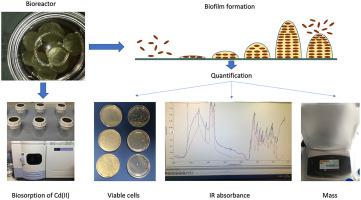Chemosphere ( IF 8.1 ) Pub Date : 2021-06-09 , DOI: 10.1016/j.chemosphere.2021.131152 Alireza Fathollahi 1 , Stephen J Coupe 1

|
Remediation of contaminated water and wastewater using biosorption methods has attracted significant attention in recent decades due to its efficiency, convenience and minimised environmental effects. Bacterial biosorbents are normally deployed as a non-living powder or suspension. Little is known about the mechanisms or rates of bacterial attachment to surfaces and effect of various conditions on the biofilm development, as well as efficiency of living biofilms in the removal of heavy metals. In the present study, the effect of environmental and nutritional conditions such as pH, temperature, concentrations of phosphate, glucose, amino acid, nitrate, calcium and magnesium, on planktonic and biofilm growth of single and mixed bacterial cultures, were measured. Actinomyces meyeri, Bacillus cereus, Escherichia coli, Pseudomonas fluorescens strains were evaluated to determine the optimum biofilm growth conditions. The Cd(II) biosorption efficiencies of the mixed-species biofilm developed in the optimum growth condition, were investigated and modelled using Langmuir, Freundlich and Dubnin Radushkevich models. The biofilm quantification techniques revealed that the optimum concentration of phosphate, glucose, amino acid, nitrate, calcium and magnesium for the biofilm development were 25, 10, 1, 1.5, 5 and 0.5 g L−1, respectively. Further increases in the nutrient concentrations resulted in less biofilm growth. The optimum pH for the biofilm growth was 7 and alkaline or acidic conditions caused significant negative effects on the bacterial attachment and development. The optimum temperatures for the bacterial attachment to the surface were between 25 and 35 °C. The maximum Cd(II) biosorption efficiency (99%) and capacity (18.19 mg g−1) of the mixed-species biofilm, occurred on day 35 (Ci = 0.1 mg L−1) and 1 (Ci = 20 mg L−1) of biofilm growth, respectively. Modelling of the biosorption data revealed that Cd(II) removal by the living biofilm was a physical process by a monolayer of biofilm. The results of present study suggested that environmental and nutritional conditions had a significant effect on bacterial biofilm formation and its efficiency in Cd(II) removal.
中文翻译:

环境和营养条件对单一和混合物种生物膜形成及其除镉效率的影响
近几十年来,使用生物吸附方法修复受污染的水和废水因其高效、方便和最小化环境影响而引起了人们的极大关注。细菌生物吸附剂通常以无生命的粉末或悬浮液的形式部署。关于细菌附着于表面的机制或速率以及各种条件对生物膜发展的影响以及活生物膜去除重金属的效率知之甚少。在本研究中,测量了环境和营养条件(如 pH 值、温度、磷酸盐、葡萄糖、氨基酸、硝酸盐、钙和镁的浓度)对单一和混合细菌培养物的浮游和生物膜生长的影响。迈耶放线菌、蜡状芽孢杆菌、大肠杆菌,评估荧光假单胞菌菌株以确定最佳生物膜生长条件。使用 Langmuir、Freundlich 和 Dubnin Radushkevich 模型对在最佳生长条件下形成的混合物种生物膜的 Cd(II) 生物吸附效率进行了研究和建模。生物膜定量技术表明,用于生物膜形成的磷酸盐、葡萄糖、氨基酸、硝酸盐、钙和镁的最佳浓度为 25、10、1、1.5、5 和 0.5 g L -1, 分别。营养物浓度的进一步增加导致更少的生物膜生长。生物膜生长的最佳 pH 值为 7,碱性或酸性条件对细菌附着和发育产生显着的负面影响。细菌附着在表面的最佳温度在 25 到 35 °C 之间。混合物种生物膜的最大 Cd(II) 生物吸附效率 (99%) 和容量 (18.19 mg g -1 ) 发生在第 35 天 (C i = 0.1 mg L -1 ) 和第 1 (C i = 20 mg L -1) 的生物膜生长,分别。生物吸附数据的建模表明,活生物膜对 Cd(II) 的去除是单层生物膜的物理过程。本研究的结果表明,环境和营养条件对细菌生物膜的形成及其去除 Cd(II) 的效率有显着影响。











































 京公网安备 11010802027423号
京公网安备 11010802027423号